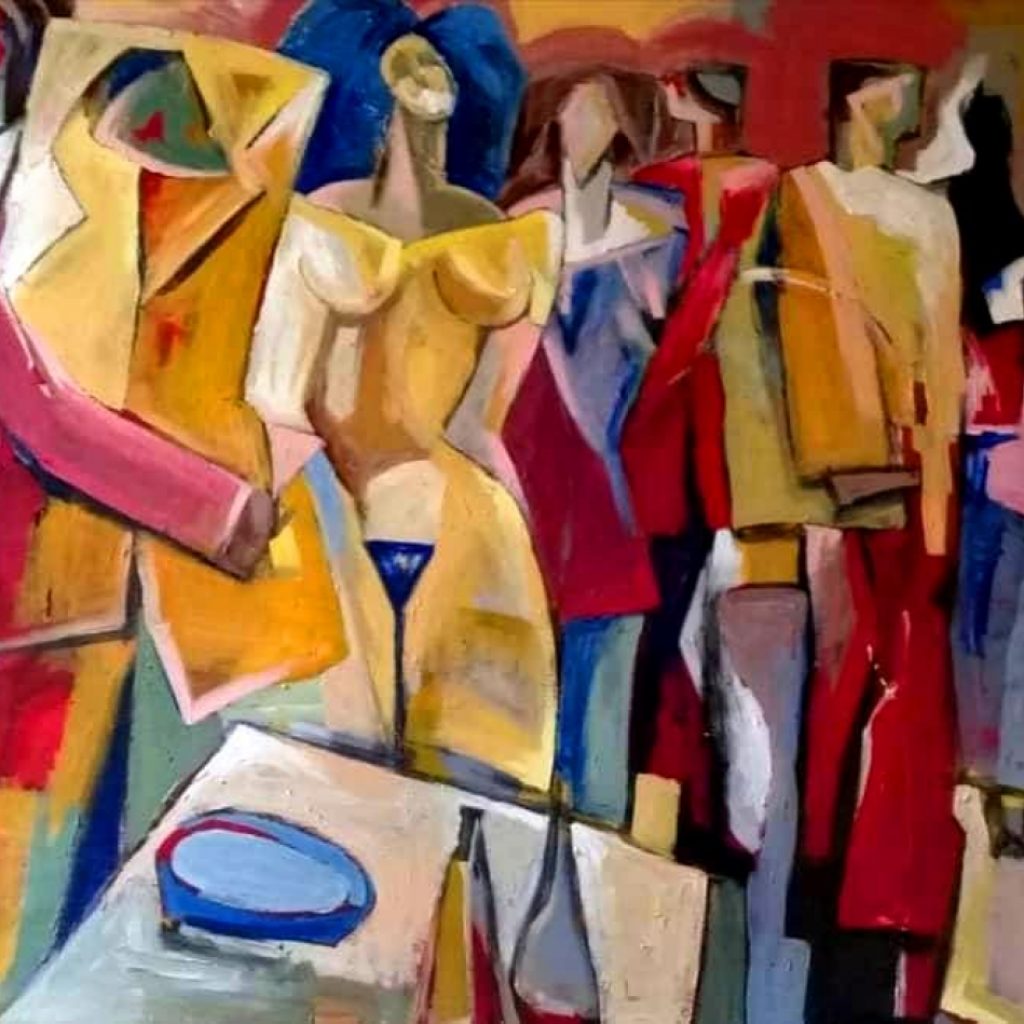It was a delightful experience to be in the company of the world-renowned Ghanaian artist Kofi Setordji. His secluded self-designed four-structure compound is nestled comfortably in the hills of Akuapim-Mampong, a town in the north district of the eastern region of Ghana. The winding maze-like red soil road makes it nearly impossible to find Kofi’s home. The compound has four building structures: The main house, the model house for visiting artists, the studio, and the material storage shed
The lush gardens surrounding Kofi’s compound are enchanting: banana, plantain, jackfruit, and cinnamon trees are among the vegetation. An arching lattice structure of white hibiscus covers the main path to his front door. I was fortunate to spend several days with Kofi to learn more about his artistic journey. Ron E. Shelton
Born in 1957, Kofi, who is largely self-taught, began his artistic career as a graphic designer and billboard painter. His creative journey gained momentum after studying with sculptor Saka-Acquaye from 1984 to 1987. He began showing his work in solo and group shows in Accra and London’s Commonwealth. After being honored with the Leisure Award Sculptor of the Year in 1990, Kofi stopped working as a commercial artist and focused on his artistic practice. He works in various mediums: painting, photography, and sculpture, using wood, metals, terracotta, and stones.
Kofi’s work explores historical themes and the everyday life and realities of his existence in Ghana, where he has always lived; he has exhibited worldwide, including shows in the USA, France, Italy, Germany, Austria, South Africa, and Denmark.
HAF: Kofi, tell me a little about your artistic journey.
Kofi: My artistic journey started when I was in secondary school. My art teacher was an exceptional man. He had a way of teaching each individual differently. He did something for me that gave me the confidence to be an artist. He had us draw in public, and everybody could criticize our work. So, the first criticism I received was in secondary school, which gave me the confidence to deal with whatever people said about my art. I first went into graphics, where you can make a living. I did commercial art for quite a while; in 1990, I decided to commit full-time to fine art. I met the renowned Ghanaian sculptor Saka-Acquaye. He taught me a lot about casting.
HAF: What countries have you traveled to?
Kofic: I first traveled in the sub-regions of Africa to learn about the traditional art forms before the Europeans came to Africa. Here we did not have written history. So I wanted to see what was still on the ground; I went to Mali, Benin, Senegal, Nigeria, and Ivory Coast to learn about art not in the cities but deep in the villages. Traveling in the Sub-region made me who I am; this is what I am made of. Out of the continent, I first went to France, Chicago, and New York. I went to Germany, Switzerland, Austria, and Italy. I have traveled but never lived there; it was only for a residency or program; I have always lived in Africa.
HAF: Tell us a little about Nubuke Foundation. Nubuke Foundation is a Ghanaian contemporary art and cultural institution based in East Legion, Accra. Founded in 2006, the Foundation serves as a nexus for preserving, recording and promoting contemporary arts and culture.
Kofi: In 1998, I founded ArtHaus; this is before Nubuke. Nubuke was formed to showcase Ghanaian artists to Ghana. In 2006 Nubuke was established, where I was Co-Founder and Artistic Director.
HAF: After finishing the workshops in Takoradi and Accra and informing youth how to weave plastic onto looms, we discussed establishing communication with the children in my community with the youth in Ghana. How do you envision this?
Kofi: Especially young people need to have a window to the world. They need to see the other side of the world. When I was growing up, we had something called PenPals.
You could choose a pen pal by writing your interests. You can share with someone who has the same interests. Creating pen pals opens the window to the world for you. You become more knowledgeable about the planet in which you live. It would be an excellent experience for children from Arthaus to communicate with youth from Cleveland and share their own stories, and people would appreciate that.
HAF: One last question. What principles do you live by?
Kofi: Hmmm. Every day I wake up, I remind myself that I will not be on this earth forever. Tomorrow could be my last day. So I live my life fully. Whatever I achieve today, I enjoy it to the fullest.















